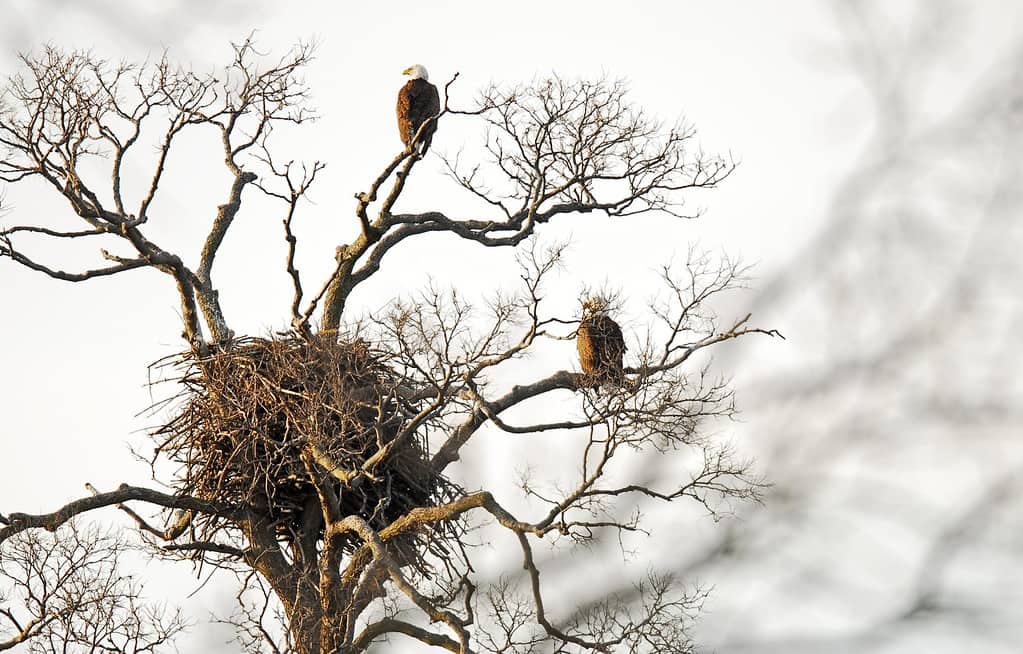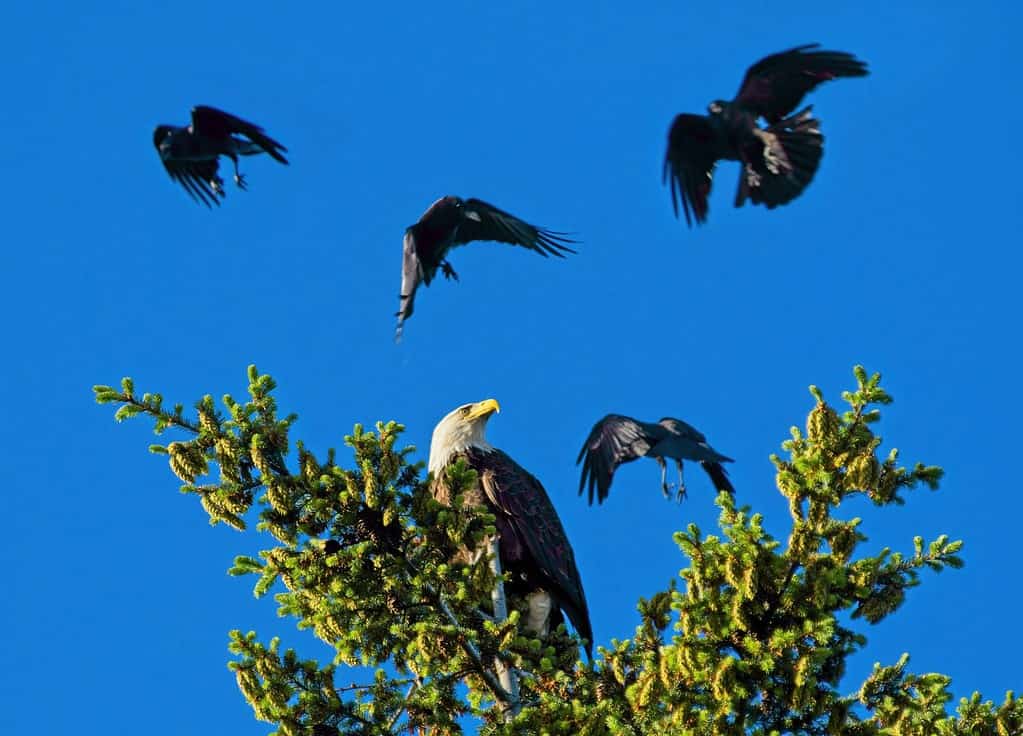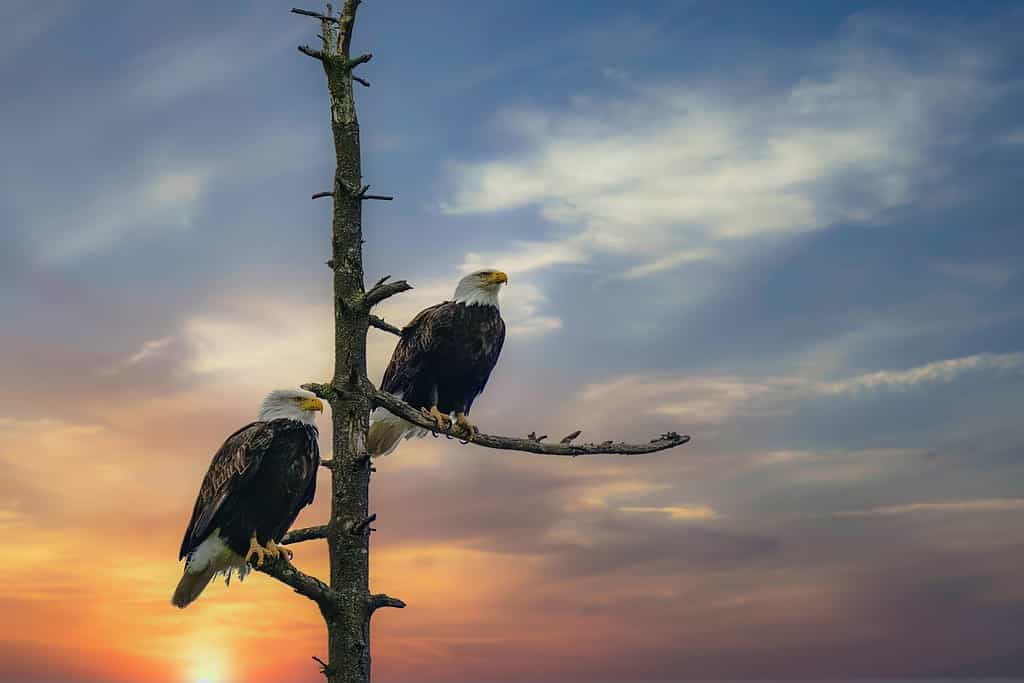Bald eagles hold a special place in American culture as the national symbol. They are also a success story in wild animal conservation. Near the brink of extinction in the 1970s, bald eagles made a dramatic comeback and are now a species of “least concern.” This is in large part due to legislation that imposes a steep price on anyone who kills one of these extraordinary birds.
How Did the Bald Eagle Become the National Bird?

The bald eagle is one of the American symbols on the reverse of the $1 bill.
©Valerii__Dex/Shutterstock.com
The founders of the United States were inspired by the Roman Republic. Because the golden eagle was a symbol of Rome, they chose the bald eagle as the American national bird and placed it on the Great Seal of the United States. When he saw the original design of the seal, Benjamin Franklin said it looked like a turkey. While it’s not true that Franklin wanted the turkey to be the national bird, he did write that the turkey was a “bird of courage,” while the eagle was a “bird of bad moral character.” In addition to appearing on the Great Seal, the bald eagle is featured on the president’s flag, the mace of the House of Representatives, on the $1 bill, on military insignia, and as a decorative element in the architecture of government buildings.
Species Description

Bald eagles have the largest nests of any animal species. They can be twice the size and depth of the one in this photo.
©Nancy Bauer/Shutterstock.com
The bald eagle (Haliaeetus leucocephalus) is a large North American raptor with a wingspan of 5′ 11″ to 7’7″ (1.8-2.3 m). The size of a bald eagle’s nest underscores how truly large these birds are. It is not only the largest bird nest in the world, but has the largest nest of any animal species, at up to 13 feet (4 m) deep, 8.2 ft (2.5 m) wide, and weighs 1 ton – as heavy as a small car!
Prey and Predators

Crows mobbing a bald eagle to drive it from their territory.
©pr2is/Shutterstock.com
Bald eagles can fly up to 43 mph (70 km/h) but can dive as fast as 99 mph (160 km/h). Their prey includes a very wide range of prey, including fish, waterfowl, snakes, turtles, and small to medium-sized mammals like rabbits or groundhogs. They are opportunistic, glad to eat roadkill and other carrion if that’s what is available to them.
Despite their formidable size and strength, eagles are vulnerable to some of the very species they prey upon. Loons have sharp bills and sometimes inflict fatal wounds on eagles that intrude on their territory. Crows sometimes work cooperatively to distract an eagle and steal its food or drive it away. Other predators like owls, raccoons, and wolverines will raid eagles’ nests while they are away to eat their eggs and chicks.
Bald Eagles’ Range

High perches with broad visibility, such as this dead tree trunk, are ideal for bald eagles.
©Wirestock/ via Getty Images
Bald eagles range through Alaska, all the Canadian provinces, the lower 48 United States, and northern Mexico. They live in diverse habitats: forests, mountains, swamps, deserts, and the sub-Arctic, but prefer to live near the sea or lakes where there are large numbers of fish. Those in colder habitats migrate in the spring and fall. Surprisingly, individual bald eagles have turned up two times in Ireland and once in the UK.
Conservation of Bald Eagles

At their most endangered, bald eagles in the United States were limited to Alaska and Florida.
©iStock.com/Kandfoto
The Near-Extinction of Bald Eagles
In the 1950s and 60s, the pesticide DDT was used extensively to combat disease-carrying mosquitos and agricultural pests. It was particularly disastrous for eagles and other birds because it caused them to lay eggs with thin shells that easily collapsed when the mother tried to incubate them. Some other threats to eagles were habitat loss, collisions with power lines and cars, and lead poisoning from eating carrion shot by hunters. Some of their greatest threats were farmers, who shot them out of fear they would carry off young farm animals. By 1963, their numbers dwindled to just 417 nesting pairs and their range shrank just to Alaska and Florida.
The Comeback of Bald Eagles
The United States started protecting bald eagles through several pieces of legislation. These included the Lacey Act (1900), the Migratory Bird Treaty (1918), and the Bald and Golden Eagle Protection Act (1940). Bald eagles were declared an endangered species in 1967 and increased the penalties for killing them over the next decade. In 1972 the government finally banned DDT and eagle populations began to recover. The 1973 Endangered Species Act was critical in preserving critical habitat. Now, there are an estimated 71,400 nesting pairs and 316,700 individual bald eagles. The bald eagle was removed from the Endangered Species Act in 2007 and the conservation status of the species is now classified as “least concern.”
Penalties for Killing Bald Eagles
Today, individuals and organizations responsible for killing bald eagles face sharp financial and legal penalties:
- Civil penalties of $5,000 or a year in prison for a first offense and $10,000 or two years in prison for a second offense.
- Criminal penalties of $250,000 or two years in prison for individuals and $500,000 for organizations.
A Success Story
Bald eagles are a conservation success story largely because of their prominent place in American culture. It’s easy to root for such a majestic, high-flying alpha predator, a symbol of a wild, unspoiled country. However, hundreds of other endangered species don’t fare as well. Usually, people are unfamiliar with them and don’t understand their role in the ecosystem. We can’t make every endangered species a national symbol, but we can increase education and appreciation so that some of them can be success stories as well.
The photo featured at the top of this post is © Jack Molan/Shutterstock.com
Thank you for reading! Have some feedback for us? Contact the AZ Animals editorial team.







